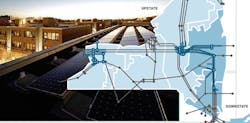NYISO Selects CPower as Aggregator in Cutting Edge New York VPP Market Plan
The system operator for the grid covering all of New York state is launching a landmark program to integrate aggregated distributed energy resources (DERs), which could include small microgrids, into wholesale electric power markets.
New York Independent System Operator (NYISO) last week announced the new market aggregation plan, which will open access for DER assets of more than 10 kW to compete in the market. These can include solar arrays, residential batteries and electric vehicles with vehicle-to-grid (V2G) bidirectional charging capabilities, all of which are also comprised in many planned microgrid projects.
The NYISO has chosen three aggregators for early participation in the program, starting with Baltimore-based energy management firm CPower Energy. The company will aggregate DERs into virtual power plants (VPPs) then bid the VPPs into the New York DER Participation Model.
“We applaud NYISO for its leadership in establishing the nation’s first program for integrating VPPs into wholesale markets,” CPower CEO Michael Smith said in a statement. “This program is an important step forward for utilizing the full spectrum of value DERs can provide and will improve grid reliability as renewable integration grows.
“We’re honored to be one of the few aggregators approved to bid into the program and look forward to working with NYISO stakeholders over the next few years to develop models to expand the reach of the program to smaller DERs and reduce remaining barriers to participation by larger customers,” Smith added.
The Federal Energy Regulatory Commission has approved the NYISO program, which itself follows up on new FERC market rules to encourage bidding of small DERs into the system. The transmission system operator oversees electricity delivery and balance for millions of New York customers, including residential, commercial, and industrial.
VPPs are like a flip side of microgrids—which are distributed generation delivering power to serve as backup or islanded power for a nearby load. Companies working to deliver VPPs via DERs do so by using an intelligent control system and bidirectional technology to aggregate energy from networked resources at a multitude of sites, such as solar-plus-storage systems, EVs and other DERs.
The VPP bundles together these resources to create a reliable power network which can be dispatched to aid the overall grid during times of peak demand, just like a real, centralized power plant could.
Several years later, FERC initiated the concept of allowing aggregated DERs into competitive markets with Order 2222. The timeline of implementation by the nation’s regional transmission and system operators has proved uneven, but several ISOs and market participants are pushing forward with projects.
Distributed energy systems such as solar and storage are growing exponentially in the U.S., albeit starting from a smaller position. Even so, the growth of renewable energy coming online is now outpacing conventional and fossil-fueled power projects annually, according to reports.
Last year, new solar installation in the U.S. soared to an all-time high of 32.4 GW for the year, or 53% of all electric generating capacity added to the grid during 2023, according to the annual report from the Solar Energy Industries Association and research firm Wood Mackenzie.
A recent study from the Brattle Group found that potential VPP capacity in California alone could exceed 7.5 GW by 2035. Brattle’s research also theorized that such capacity could save consumers more than $550 million annually in utilizing VPPs over traditional, physical power system costs.
The Electric Reliability Council of Texas, which manages most of that state’s grid, also has set VPP pilot projects into motion. ERCOT wants to avoid a grid generation capacity crisis such that it experienced during Winter Storm Uri in 2021.
CPower Energy was one of the presenters and exhibitors at the Microgrid Knowledge Conference in Baltimore April 22-24. Microgrid Knowledge 2025 will be in Dallas on April 15-17. More details later.
About the Author
Rod Walton, Microgrid Knowledge Managing Editor
Managing Editor
For Microgrid Knowledge editorial inquiries, please contact Managing Editor Rod Walton at [email protected].
I’ve spent the last 15 years covering the energy industry as a newspaper and trade journalist. I was an energy writer and business editor at the Tulsa World before moving to business-to-business media at PennWell Publishing, which later became Clarion Events, where I covered the electric power industry. I joined Endeavor Business Media in November 2021 to help launch EnergyTech, one of the company’s newest media brands. I joined Microgrid Knowledge in July 2023.
I earned my Bachelors degree in journalism from the University of Oklahoma. My career stops include the Moore American, Bartlesville Examiner-Enterprise, Wagoner Tribune and Tulsa World, all in Oklahoma . I have been married to Laura for the past 33-plus years and we have four children and one adorable granddaughter. We want the energy transition to make their lives better in the future.
Microgrid Knowledge and EnergyTech are focused on the mission critical and large-scale energy users and their sustainability and resiliency goals. These include the commercial and industrial sectors, as well as the military, universities, data centers and microgrids. The C&I sectors together account for close to 30 percent of greenhouse gas emissions in the U.S.
Many large-scale energy users such as Fortune 500 companies, and mission-critical users such as military bases, universities, healthcare facilities, public safety and data centers, shifting their energy priorities to reach net-zero carbon goals within the coming decades. These include plans for renewable energy power purchase agreements, but also on-site resiliency projects such as microgrids, combined heat and power, rooftop solar, energy storage, digitalization and building efficiency upgrades.

